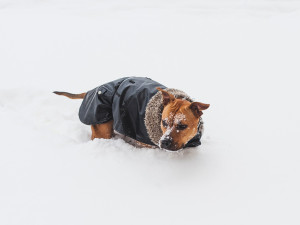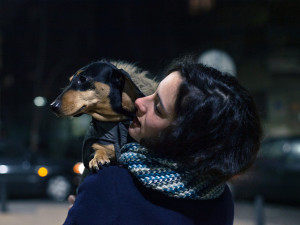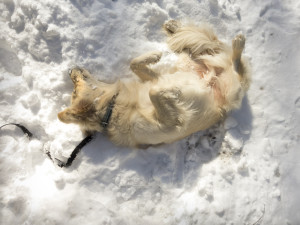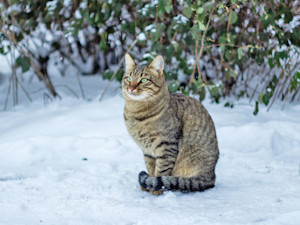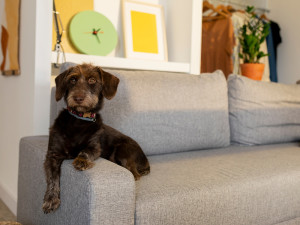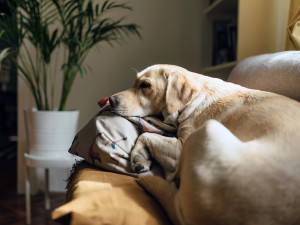Walking Your Dog After Dark? 8 Tips for Safe and Enjoyable Night Walks
Gear up and get out there – even when it’s pitch black at 4pm
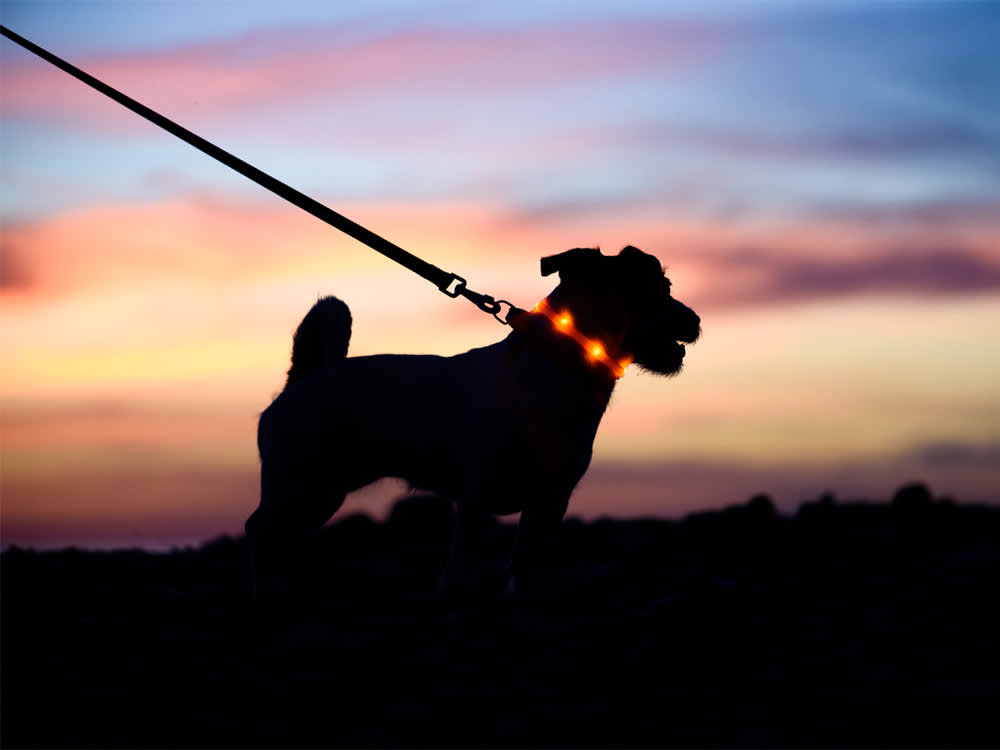
Share Article
It’s that time of year again – when morning and evening dog walks are shrouded in darkness. With limited daylight during the workweek and the occasional bright weekend, it can feel like a constant battle against the dark. But while our pups need their exercise year-round, night-time walks bring challenges, from limited visibility to general safety concerns.
Recent research by non-profit Strut Safeopens in new tab and New Acres (a built-for-rental scheme home by Legal & General) shows that 54 percent of women who walk their dogs less in winter do so because they feel less safe in the dark. In fact, over a third of women say they dread the clocks going back for this reason, with many beginning to feel unsafe as early as 6.30pm.
Of course, walking in daylight is preferable but with the right preparation, walks at night can be safe, enjoyable, and even peaceful for both you and your pet. With the help of professional dog walker, Emily Leightleyopens in new tab, and advice from the PDSAopens in new tab we’ve put together a guide including tips and advice on walking your dog safely at night.
Can I walk my dog at night?
Walking anywhere whether alone or with your dog is always best during the bright hours. Lighting, wildlife, traffic and weather are just a few of the dangers that the darkness brings.
It’s advised to walk your dog as early as possible in the evening if you can, for example, as soon as you get home from work to avoid the complete darkness and quietness of the night. However, we lead busy lives and in the winter, with evenings getting dark as early as 3.30pm in the UK, this might just not be possible.
So, if your only option is walking at night, don’t worry, it is absolutely possible to walk your dog in the dark if you take the correct precautions.
Tips for walking your dog at night
1. Gear up for visibility
“Preparedness and visibility are crucial, especially in the low light conditions at this time of year,” says PDSA veterinary nurse Gemma Renwick. “Make sure your dog is microchipped and wears a collar with up-to-date identification details – not only is it a legal requirement but preparing in this way will help keep your pet safe.
“Whilst it’s always better to walk dogs in daylight, it isn’t always possible during winter months – so make sure drivers can see both you and your pet clearly,” she adds. “Wearing bright-coloured clothing or even a high visibility jacket will help drivers spot you, whilst an LED collar or high visibility dog coat will ensure your furry friend can be seen.”
“One of the most important aspects of walking your dog at night is ensuring that both of you are highly visible to others, especially cars, cyclists and other pedestrians,” says Emily. She recommends investing in the following equipment:
Reflective gear for you and your dog
Investing in reflective gear can make a big difference in visibility. “Consider reflective leads, collars or harnesses for your dog, and wear a reflective vest or jacket yourself. This will help drivers spot you from a distance, reducing the risk of accidents,” says Emily.
LED lights and glow collars
LED collars or collar attachments are another fantastic option. They provide a bright, noticeable glow that’s hard to miss. “There are also LED leads that light up, making it even easier for others to see you. Plus, these lights can help you spot your dog more easily in dimly lit areas or large open spaces,” adds Emily.
Headlamps or torches
A hands-free headlamp or a small flashlight can illuminate your path, making it easier to see uneven ground, obstacles or even wildlife. “Headlamps also let you keep your hands on the lead, which is especially helpful if your dog tends to pull or get excited by things in the dark,” says Emily.
2. Consider walking with a partner or in a group
If you’d feel safer with company, consider walking with a friend, family member or even setting up a small dog-walking group.
Join local dog walking groups
Many communities have local dog-walking groups; if yours doesn’t, why not consider starting one! For example, New Acres recently teamed up with Strut Safe to create Walk in Packsopens in new tab – a community initiative that gives residents and their dogs a chance to walk together for added safety.
Walking with a group can make the experience more enjoyable and provide an extra layer of safety. Plus, it’s a great way for your dog to socialise, even when it's dark.
Share your location with someone you trust
If you’re walking alone in a new area, consider sharing your location with someone (via apps such as Find My Friends and Google Location Sharing) or informing them of your route. This way, someone knows where you are in case of an emergency and can make note when you’re back home safe and sound.
3. Stick to familiar and well-lit routes
Night-time is not the best time for exploring new trails or unlit areas. To ensure a safe and stress-free walk, stick to paths you know well and that have good lighting.
Choose routes with streetlights or other well-lit areas
Select streets and parks that are well-lit to make it easier to see and avoid hazards. Well-lit paths also discourage potential dangers such as wildlife and reduce the risk of encountering unsafe situations for both you and your dog.
“When planning your walking route, avoid high-speed, busy roads without pavements and use pedestrian crossings whenever possible,” says Gemma. “If you find it difficult to cross a road safely, consider returning by the same route you came.”
Avoid going off lead in the dark
“Even if your dog is typically well-behaved off lead, when it's dark isn’t the ideal time for off-lead play,” says Emily. “Dogs can become disoriented in low light and may get lost or injured more easily. Keeping them on a lead provides an added layer of control and safety.”
4. Training and cues: reinforce good behaviour
With heightened distractions at night, reinforcing your dog’s training and lead manners becomes crucial.
Practice recall cues
“Even on a lead, it’s helpful to have reliable recall commands. Practice cues such as ‘come’, ‘leave it’ and ‘heel’ regularly to keep your dog focused on you,” says Emily. “If your dog tends to pull, consider using a no-pull harness for better control.”
Teach your dog to focus on you
Some dogs get spooked or overly excited at night by noises, shadows or other animals. Teaching your dog to focus on you can help them feel more secure. “Try practising cues such as ‘look’ or ‘watch me’ to keep their attention on you instead of potential distractions,” adds Emily.
Training leads to habits
“Whilst you won’t be able to teach your canine companion to look left and right, you can use simple cues to help keep them safe,” says Gemma. “When approaching a road with your dog on a lead, first ask them to ‘sit’ and ‘wait’. Once your dog is sitting calmly and you’re happy the road is clear, give the cue to ‘walk’ (or ‘heel’) and cross together carefully. This way, your dog will learn to automatically sit and wait for your command before crossing any road.”
5. Protect your dog from the elements
“The colder months bring their own set of challenges for night walks,” says Emily. “Rain, snow and cold temperatures require some extra prep.”
Dress for the weather
If it’s chilly outside, consider putting a dog coat or sweater on your pet. “Breeds with short coats or smaller dogs, in particular, can benefit from extra warmth,” says Emily. “You may also want to wear warm, water-resistant clothing to keep yourself comfortable,”
Protect their paws
Salt and ice on the ground can irritate your dog’s paws – not to mention salt and de-icer being toxic to dogs. “Try dog booties if your dog is comfortable wearing them, or apply a paw balm before and after the walk,” says Emily. “Wiping their paws with a cloth when you get home will help remove any residual salt or dirt.
Stay dry with rain gear
“If there’s a chance of rain, consider investing in a waterproof jacket for your dog as well as a raincoat or umbrella for yourself. This way, you both stay dry and comfortable,” she advises. However, never force your dog to wear anything they don’t seem to be comfortable in.
6. Carry essentials: be prepared for anything
Just because it’s a walk in the dark doesn’t mean you should leave the essentials at home. As a dog walker, Emily always ensures to bring essentials such as:
Bring poo bags
Dog walkers know that nature calls regardless of the time of day. “Bring poo bags and dispose of waste properly to keep the area clean. Plus, think of others! In the dark weather with fallen leaves, standing on nasty surprises is a lot more difficult to avoid,” says Emily.
Water for hydration
Even in cooler weather, dogs can get thirsty. “Carry a small water bottle and a collapsible bowl if your walk is going to be lengthy, especially if your dog tends to get thirsty.”
Treats for positive reinforcement
Carry treats to reward your dog for good behaviour or as a distraction from any potential night-time scares. “Treats can also be useful if you need to redirect your dog’s attention away from a sudden distraction, such as another dog or a loud noise,” adds Emily.
7. Be mindful of your dog’s senses
Dogs rely heavily on their senses, and night-time walks can feel very different to them than daytime strolls.
Let them sniff and explore
At night, familiar smells can become amplified, and new scents may appear. “Allow your dog to explore these smells; sniffing can be both stimulating and reassuring for them,” says Emily. “Give them time to take in their surroundings, as it can make the walk more enjoyable and calming.”
Watch for startle responses
Some dogs may be startled by night-time noises or shadows. “If your dog seems spooked, speak to them calmly and continue moving. Avoid comforting them excessively, as this can reinforce their fear. Instead, project a calm demeanour to reassure them that everything is fine,” advises Emily.
8. Pay attention to your own safety
Your dog’s safety is vital, but don’t forget to prioritise your own as well.
Stay aware of your surroundings
Avoid distractions such as checking your phone constantly. Stay alert, as this will help you stay aware of potential hazards or oncoming pedestrians or cyclists.
Avoid using headphones
Using headphones whilst walking your dog can make it difficult to hear approaching cars, cyclists or other people. Instead, walk without them or use a single earbud at a low volume to stay aware of your surroundings.
Walk confidently and in open spaces
If you’re in an area that feels a bit isolated, walk confidently and stay in open, visible areas where you’re less likely to encounter unwanted attention.
Walking in the dark with your dog doesn't have to be frightening. By using reflective gear, sticking to familiar routes, keeping your dog on a lead and being prepared with essentials like water and treats, you can make these winter walks safe and enjoyable.
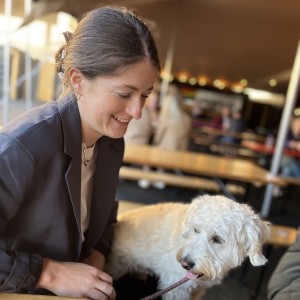
Nuala McHugh
Nuala is a writeropens in new tab with a background in PR. She has worked with brands including Jollyes, Universal Studios, and Amazon. Based in Northern Ireland, she is now doing what she loves most: writing with her clingy cockapoo Bobby by her side.
Related articles
![Woman taking a night walk with her small black dachshund.]()
How Do I Know If My Dog Is Afraid of the Dark?
If your dog is reluctant to go outside in the evening (or 4pm as it’s known in winter), there might be a good reason
![Cat in the snow]()
Winter Pet Hazards: Keep Your Pets Safe This Season
Winter brings hidden dangers for pets – find out how to keep them safe
![sick dog lying on sofa]()
Can Dogs Actually Get the Common Cold?
You’re sneezing, blowing your nose and stocking up on Lemsip. But is your pup at risk of catching your cold?
![a woman pets her dog in a coat while outside in the snow]()
How Cold is Too Cold for Dogs?
If your teeth are chattering, theirs probably are, too

